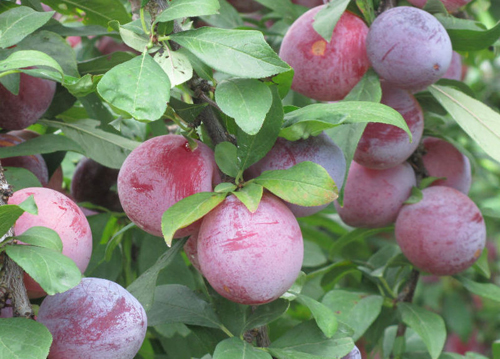Plum variety Candy
There is very little information about the plum variety with such a delicious name Candy. It is not yet listed in the State Register. It is known that it was created by Professor G.A.Kursakov at the Michurinsk branch of VOGiS. According to some reports, our heroine is the result of crossing Early with Montfort. The culture shows the best results in the Central region of Russia (Ryazan, Tula, Smolensk, Vladimir, Kaluga, Moscow, Ivanovo, Bryansk regions).
Description
The tree is attractive, of medium vigor, compact, up to 2.5 meters high, but no more than 3. The crown is wide, spreading, oval in shape. Candy can be formed as a standard or bush plant, thanks to which the variety is popular with landscape designers. The bark of upright shoots is brown with a grayish bloom. The leaves are emerald green, slightly wrinkled, the surface is not pubescent, the edges are jagged. The petiole is ordinary, uncolored. The flowers of the variety are snow-white, small, abundant flowering.

Plum fruits are elongated, with an average weight of 30 grams, the largest - up to 35 - 38 grams. The skin is thin, dark red-violet or red-purple, covered with a thin layer of bluish wax bloom. The pulp is honey-yellow, with green. The pulp is moderately firm, tender, juicy. The taste is excellent - sweet, reminiscent of marmalade. Tasters' score - 5 points, but overripe fruits taste sugary. The juice is colorless. The stone is small, elongated, flat. It is separated from the pulp by half. The peduncle is medium, may have traces of anthocyanin coloration.
Variety characteristics
- Candy is considered early, the crop appears 4 years after planting;
- plum is appreciated for its early ripeness - ripe fruits can be harvested from mid-July, and even earlier in the southern regions;
- unfortunately, ripening does not occur simultaneously, if the fruit is not removed in time, the pulp will quickly overripe, and there is a threat of shedding;
- the yield of the plant is good - a small tree can form 25 - 30 kg of fruits;
- frost resistance for the Central region of Russia is sufficient - the tree can withstand -20 ° C. For cooler areas, this figure is below average;
- the variety has a high resistance to major diseases of stone fruit;
- the transportability of the fruits is not very good, the shelf life is short;
- the way of using plums is dessert. In its natural form, fruits will bring many benefits and delight in taste. They are practically not used for processing.

Pollinators
Candy is a self-fertile variety. A suitable pollinator must be planted in a pair with it. But due to the too early flowering of the variety, there is a problem with the selection of a suitable plant. According to gardeners, early-flowering thorny plums do well with the task. Fit from the plums Kolkhoz renklode and Zarechnaya early.
Planting and leaving
Plants can be planted in autumn or spring. The main thing is not to miss the deadline. Spring planting will require more careful tree care. For disembarkation, try to choose the warmest and sunniest area. The soil should be loose and have neutral acidity. The distance to neighboring trees is at least 3 meters. Caring for the variety is not difficult. Watering is carried out as needed, increasing the frequency of moisture in the dry season. Pruning, freeing the crown from excessive thickening, is performed in the spring, sanitary - as needed. Top dressing is carried out according to the generally accepted scheme - nitrogen-containing compounds are introduced in the spring, superphosphate compounds in the fall. Potash fertilizers can be replaced by adding wood ash.Don't forget about preventative treatments that increase disease resistance. In cool regions in winter, the root zone is insulated with a layer of mulch of 15 - 20 cm.
Candy is appreciated among gardeners for its early yield and excellent taste. It is easy to grow, its compact size will perfectly fit a plum into any, even a small garden. The disadvantages are poor transportability of fruits and their insufficient keeping quality. In addition, you will have to harvest the crop in a timely manner so as not to lose it.








